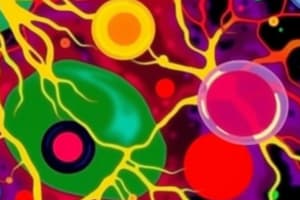Podcast
Questions and Answers
What role does cholesterol play in the structure of the membrane?
What role does cholesterol play in the structure of the membrane?
Which type of protein can easily detach from the membrane?
Which type of protein can easily detach from the membrane?
What is the main characteristic of the fluid mosaic model of membranes?
What is the main characteristic of the fluid mosaic model of membranes?
What is the effect of hydrogen bonding on the membrane structure?
What is the effect of hydrogen bonding on the membrane structure?
Signup and view all the answers
What type of molecules are glycoproteins and glycolipids primarily composed of?
What type of molecules are glycoproteins and glycolipids primarily composed of?
Signup and view all the answers
What is the primary function of mitochondria in a cell?
What is the primary function of mitochondria in a cell?
Signup and view all the answers
Which of the following correctly describes microtubules?
Which of the following correctly describes microtubules?
Signup and view all the answers
What role do centrioles play in animal cells?
What role do centrioles play in animal cells?
Signup and view all the answers
Which component makes up approximately 50% of the cell membrane structure?
Which component makes up approximately 50% of the cell membrane structure?
Signup and view all the answers
What is a key function of the cell membrane?
What is a key function of the cell membrane?
Signup and view all the answers
Intermediate filaments are described as:
Intermediate filaments are described as:
Signup and view all the answers
What characteristic is true of mitochondria during cell division?
What characteristic is true of mitochondria during cell division?
Signup and view all the answers
Which of the following statements about the cytoskeleton is correct?
Which of the following statements about the cytoskeleton is correct?
Signup and view all the answers
What is the primary characteristic of the fluid mosaic model of membranes?
What is the primary characteristic of the fluid mosaic model of membranes?
Signup and view all the answers
Which factor does NOT affect membrane fluidity?
Which factor does NOT affect membrane fluidity?
Signup and view all the answers
Which of the following is NOT a function of membrane proteins?
Which of the following is NOT a function of membrane proteins?
Signup and view all the answers
What characteristic allows phospholipids to form membranes?
What characteristic allows phospholipids to form membranes?
Signup and view all the answers
Membrane proteins can move in and out constantly due to which property of membranes?
Membrane proteins can move in and out constantly due to which property of membranes?
Signup and view all the answers
How many transmembrane domains do proteins need to be anchored in the membrane?
How many transmembrane domains do proteins need to be anchored in the membrane?
Signup and view all the answers
Which membrane protein function is primarily involved in cell recognition?
Which membrane protein function is primarily involved in cell recognition?
Signup and view all the answers
What primarily drives membrane dynamics, such as lateral movement of phospholipids?
What primarily drives membrane dynamics, such as lateral movement of phospholipids?
Signup and view all the answers
What is the primary role of ATP in cellular transport mechanisms such as the Na+-K+-ATPase?
What is the primary role of ATP in cellular transport mechanisms such as the Na+-K+-ATPase?
Signup and view all the answers
Which process involves the net diffusion of water across a membrane?
Which process involves the net diffusion of water across a membrane?
Signup and view all the answers
What creates the concentration gradient that facilitates osmosis?
What creates the concentration gradient that facilitates osmosis?
Signup and view all the answers
Which statement about osmosis is true?
Which statement about osmosis is true?
Signup and view all the answers
Which of the following substances would primarily affect osmotic concentration in a solution?
Which of the following substances would primarily affect osmotic concentration in a solution?
Signup and view all the answers
What mechanism do Paramecium cells use to maintain osmotic balance?
What mechanism do Paramecium cells use to maintain osmotic balance?
Signup and view all the answers
What type of transport requires energy to move substances against their concentration gradient?
What type of transport requires energy to move substances against their concentration gradient?
Signup and view all the answers
Which of the following accurately describes a characteristic of the sodium-potassium (Na+-K+) pump?
Which of the following accurately describes a characteristic of the sodium-potassium (Na+-K+) pump?
Signup and view all the answers
Which type of carrier protein moves two molecules in opposite directions?
Which type of carrier protein moves two molecules in opposite directions?
Signup and view all the answers
What is the primary role of P-type ATPases in cellular transport?
What is the primary role of P-type ATPases in cellular transport?
Signup and view all the answers
What is a common feature of ATP-dependent membrane transporters?
What is a common feature of ATP-dependent membrane transporters?
Signup and view all the answers
How does the sodium-potassium pump change the affinity of its carrier protein?
How does the sodium-potassium pump change the affinity of its carrier protein?
Signup and view all the answers
Which transport mechanism maintains cells isotonic with their environment?
Which transport mechanism maintains cells isotonic with their environment?
Signup and view all the answers
Why is energy (ATP) crucial for active transport processes?
Why is energy (ATP) crucial for active transport processes?
Signup and view all the answers
What is the role of ABC transporters?
What is the role of ABC transporters?
Signup and view all the answers
Study Notes
Mitochondria
- The cell's powerhouse, responsible for metabolizing sugars to produce ATP for cellular energy.
- Division is separate from cell division – mitochondria double and partition.
- Mitochondrial dysfunction can lead to specific diseases.
Cytoskeleton
- Composed of three types of fibers:
- Microfilaments (actin filaments): two intertwined protein chains, involved in movements like contraction, crawling, and "pinching."
- Microtubules: largest cytoskeletal elements, made of α- and β-tubulin dimers, facilitate cell movement and material transport within the cell.
- Intermediate filaments: intermediate in size, very stable and rarely broken down.
Centrosomes
- Region surrounding the nucleus in almost all animal cells, containing specialized units called centrioles.
- Act as microtubule-organizing centers, "nucleating" the assembly of microtubules.
- Found in animal cells and most protists, but usually absent in plants and fungi.
Cell Membranes
- Surround all living cells and are only 4 nanometers thick.
- Essential for life, defining the cell boundary and regulating what enters and exits the cell.
- Also known as the plasma membrane, supports the cell, allows cell signaling and recognition, and defines the boundaries of organelles within the cell.
Membrane Structure
- Composed of:
- Phospholipids arranged in a bilayer (approximately 50%).
- Proteins inserted in the bilayer (approximately 50%):
- Integral proteins (e.g., connexins): sometimes glycosylated.
- Peripheral proteins (e.g., clatherin adaptor protein): can separate from the membrane.
- Cholesterol (and other sterols): make the membrane less permeable to hydrophilic molecules.
- Hydrogen bonding of water holds the two layers together.
- Fluid structure: proteins and lipids in the membrane can move easily.
Fluid Mosaic Model
- Proteins float in or on the fluid lipid bilayer like icebergs in the sea.
Membrane Fluidity
- Membranes are dynamic and active.
- Phospholipids move laterally and sometimes transversely (flip-flop).
- Fatty acid composition and temperature affect fluidity.
Hydrophilic/Hydrophobic Charges
- Hydrophilic/hydrophobic charges allow phospholipids to form membranes.
Membrane Proteins
- Various functions:
- Transporters
- Enzymes
- Cell-surface receptors
- Cell-surface identity markers
- Cell-to-cell adhesion proteins
- Attachments to the cytoskeleton
Transmembrane Proteins
- Often have multiple transmembrane domains to anchor proteins to the membrane.
Transport
- Movement from low to high concentration.
- Utilizes carrier proteins and cell channels (e.g., Na+-K+-ATPase).
- Requires energy (ATP).
Osmosis
- Net diffusion of water across a membrane toward a higher solute concentration.
- Occurs when a membrane separates two solutions with different solute concentrations.
Osmotic Concentration
- The concentration of all solutes in a solution determines its osmotic concentration.
Maintaining Osmotic Balance
- Some cells use extrusion, where water is ejected through contractile vacuoles.
- Isosmotic regulation involves keeping cells isotonic with their environment (extrusion, isosmotic regulation, turgor).
Active Transport
- Movement of materials against a concentration gradient using energy (ATP).
- Utilizes carrier proteins:
- Uniporters: transport one molecule at a time.
- Symporters: transport two molecules in the same direction.
- Antiporters: transport two molecules in opposite directions.
Cotransport
- Symport and antiport: animation
ATP-dependent Membrane Transporters
- P-type ATPases: undergo phosphorylation, transport Na+, K+, and Ca2+.
- F-type ATPases: proton-transporters in mitochondria and bacteria.
- V-type ATPases: in lysosomes.
- A-type ATPases: anion transporters.
- ABC transporters: have an ATP-binding cassette and transport ions, metabolites, and drug molecules.
Sodium–Potassium (Na+–K+) Pump
- Also known as the (Na+-K+)-ATPase.
- Uses ATP directly for active transport.
- Is an antiporter: moves 3 Na+ out of the cell and 2 K+ in against their concentration gradients.
- Changes conformation using ATP energy.
- Affinity of the carrier protein for Na+ or K+ changes to permit transport across the membrane.
- Uses a significant amount of cellular energy (over 1/3 in non-dividing cells).
Studying That Suits You
Use AI to generate personalized quizzes and flashcards to suit your learning preferences.
Related Documents
Description
This quiz covers fundamental aspects of cell biology, focusing on organelles such as mitochondria, the cytoskeleton, centrosomes, and cell membranes. Understand their functions, structures, and significance within the cell. Perfect for students looking to enhance their knowledge of cellular components.





